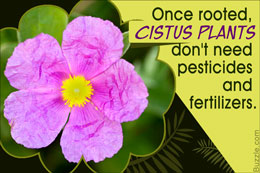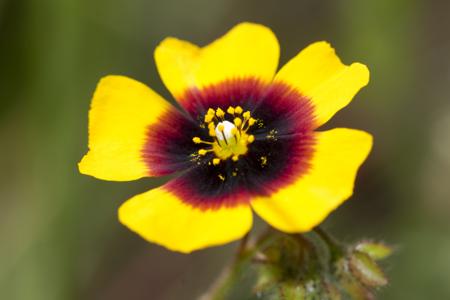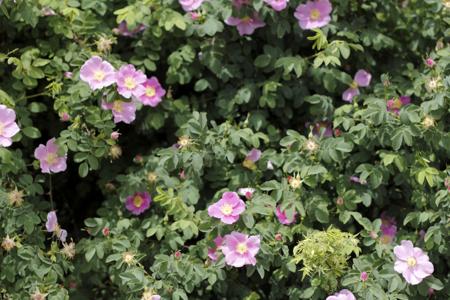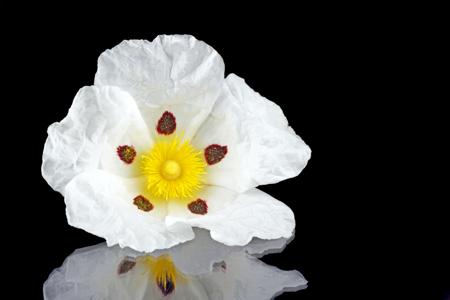As the name suggests, Rock Rose plants are tough enough to stand cold winters, hot summers, and droughts. Buzzle presents some interesting facts about these plants and explains how easily you can enhance the beauty of your garden.

Did You Know?Medicinal properties of Cistus were first discovered by some shepherds thousands of years ago. The gum of the Cistus shrubs used to get stuck in the coats of grazing sheep and goats. The shepherds, while trying to remove it from the coat, had to rub their hands in the gum. They noticed that cuts on their hands disappeared quickly as they rubbed them against the gum. Eventually they thought of using the gum for wound healing and quick restoration of smooth skin.Cistus plants are native to the dry, rocky parts of the Mediterranean region (Morocco, Portugal, and Middle Eastern countries), and Canary Islands. The name Cistus is derived from the original Greek name
Kistos, meaning basket. Rock Rose plants are evergreen flowering plants. The name 'Rock Rose' denotes various ornamental plants in two genera,
Cistus and
Halimium, that belong to the family Cistaceae. These perennial shrubs produce abundant flowers and help enhance the beauty of a garden. They are cultivated for the resin-scented foliage and eye-catching flowers. Rock Rose has gained the Royal Horticultural Society's Award of Garden Merit (AGM).
A Cistus plant is best propagated from cuttings. The plants should be planted in well-drained soil in a sunny spot. They can be a part of gravel garden, a slope or raised bed is more suitable. You may plant them from May to September. There is no need of adding fertilizer or organic material to the soil. Moreover, insect pests do not like the thick leaves of Cistus plants. You may have to water them during their first growing season. Once rooted, they don't need pesticides, regular watering, and fertilizers. So, these are easy-to-maintain plants.SpeciesThere exist about 20 species in the genus
Cistus, for example,
Cistus ladanifer, Cistus laurifolius, Cistus monspeliensis, Cistus salviifolius, Cistus creticus, Cistus incanus, etc.
Cistus pulverulentus, commonly known as 'Sunset Rock Rose', is sold as a garden plant. It is a natural hybrid of
Cistus albidus (white Rock Rose) and
Cistus crispus (wrinkle-leaved Rock Rose). It produces clusters of yellow-centered, rose-pink flowers. The resin bearing species, especially
C. ladanifer, is commonly known as
gum cistus. The cultivar 'Brilliancy' (
Cistus x purpureus) produces deep rosy pink flowers with burgundy spots. 'Silver pink' is also an attractive variety. Numerous varieties of Cistus plants are available worldwide.



HabitatThese wild plants grow well on dry hills, scrubs, and open woodlands. They are usually seen at an altitude of 0-1,200 meters (0-3,937 ft) above sea level. It has been noticed that these plants grow vigorously and very quickly after a fire. They can be described as extremely aggressive plants. Once rooted, they can tolerate dry conditions. They require very little or no irrigation.DescriptionThese decorative plants are classified as evergreen shrubs. They thrive in the most rocky, arid soil. They can be 3 feet tall and wide. Some species can be 8 feet tall and wide. So, they should be planted with ample space. The plants have a hairy, glandular texture. The visible surfaces of the lanceolate leaves are dark green, but they are paler underneath. The surface of the leaves is slightly rough. As they are covered with the oozing resin, they are sticky. The highly aromatic oleoresin, known as labdanum, secreted by the leaves of these plants, is used in perfumes, especially as a fixative. Arid conditions (hot summers) promote resin production. During summer, the plant releases the sticky resin along its leaves and branches. Some species have linear wrinkled leaves. The fruit looks like a pentagonal capsule. It is 5-7 mm long. The leaves are up to 5 centimeters long. The diameter of a flower can be 5-8 cm. The plant flowers once a year, in late spring and early summer. The plant performs best in full sun. The shrubs look attractive in groups.
All varieties are good as they produce profuse flowers that have five papery, wrinkled petals. These showy petals have a bright yellow or crimson spot at the base. The inflorescence being a panicle of 2 to 8 flowers, the plants are beautifully covered with flowers. Color of the flowers can be yellow, pink, or white. Cistus flowers open in the morning and fall off the plant by mid afternoon. But fresh new flowers bloom the next day. With profuse flowering, the plant is always covered with colorful flowers throughout the summer. In some species, the flowers are solitary, but usually, they are in small clusters. The typical lifespan of the plant in cultivation is 8-10 years. Some species self seed.PruningPurple Rock Rose (
Cistus x purpureus), which gives purple flowers, grows 4 feet tall and 5 feet wide. Pink Rock Rose (
Cistus x skanbergii ) grows 2 to 4 feet tall and 4-6 feet wide. It produces 1 inch wide pink flowers. Timely pruning can give these shrubs, a compact, rounded shape. Trim the stems that spoil the shape and beauty of the plant. Light pruning promotes bushy growth. The plant should never be pruned hard. Once cut, the branches would be automatically regenerated for the next summer. This plant is described as 'the plant of survival, renewal, and rebirth'.Cistus UsesThe oil obtained from steam, distilled from the leaves of wild
Cistus ladaniferus, comes with a soft, fruity smell. It is also known as Rock Rose or Labdanum oil. For centuries, it has been used for meditation. It is known for its calming effect and is one of the most sought-after oils of aromatherapy. It exhibits antimicrobial, astringent, hemostatic and tissue-healing properties. The oil can help uplift your mood. Diluted oil can be applied on wounds and cuts. With regular application, your skin can look soft, supple, and young. It can boost your immune system too. It can be used as a tonic. Blended with German chamomile, it can be used to treat chronic skin conditions like psoriasis, eczema, etc. For skin rejuvenation, it can be added to various skin-care products.Cistus plants look more attractive when planted with other Mediterranean shrubs like rosemary, lavender and santolina. They flower at the same time. The plants also go well with genistas,
Piptanthus nepalensis (laburnum),
Convolvulus cneorum (silverbush). It is very easy to grow Cistus plants, as they are generally disease-free and pest-free.






 Did You Know?Medicinal properties of Cistus were first discovered by some shepherds thousands of years ago. The gum of the Cistus shrubs used to get stuck in the coats of grazing sheep and goats. The shepherds, while trying to remove it from the coat, had to rub their hands in the gum. They noticed that cuts on their hands disappeared quickly as they rubbed them against the gum. Eventually they thought of using the gum for wound healing and quick restoration of smooth skin.Cistus plants are native to the dry, rocky parts of the Mediterranean region (Morocco, Portugal, and Middle Eastern countries), and Canary Islands. The name Cistus is derived from the original Greek name Kistos, meaning basket. Rock Rose plants are evergreen flowering plants. The name 'Rock Rose' denotes various ornamental plants in two genera, Cistus and Halimium, that belong to the family Cistaceae. These perennial shrubs produce abundant flowers and help enhance the beauty of a garden. They are cultivated for the resin-scented foliage and eye-catching flowers. Rock Rose has gained the Royal Horticultural Society's Award of Garden Merit (AGM).
Did You Know?Medicinal properties of Cistus were first discovered by some shepherds thousands of years ago. The gum of the Cistus shrubs used to get stuck in the coats of grazing sheep and goats. The shepherds, while trying to remove it from the coat, had to rub their hands in the gum. They noticed that cuts on their hands disappeared quickly as they rubbed them against the gum. Eventually they thought of using the gum for wound healing and quick restoration of smooth skin.Cistus plants are native to the dry, rocky parts of the Mediterranean region (Morocco, Portugal, and Middle Eastern countries), and Canary Islands. The name Cistus is derived from the original Greek name Kistos, meaning basket. Rock Rose plants are evergreen flowering plants. The name 'Rock Rose' denotes various ornamental plants in two genera, Cistus and Halimium, that belong to the family Cistaceae. These perennial shrubs produce abundant flowers and help enhance the beauty of a garden. They are cultivated for the resin-scented foliage and eye-catching flowers. Rock Rose has gained the Royal Horticultural Society's Award of Garden Merit (AGM).

 HabitatThese wild plants grow well on dry hills, scrubs, and open woodlands. They are usually seen at an altitude of 0-1,200 meters (0-3,937 ft) above sea level. It has been noticed that these plants grow vigorously and very quickly after a fire. They can be described as extremely aggressive plants. Once rooted, they can tolerate dry conditions. They require very little or no irrigation.DescriptionThese decorative plants are classified as evergreen shrubs. They thrive in the most rocky, arid soil. They can be 3 feet tall and wide. Some species can be 8 feet tall and wide. So, they should be planted with ample space. The plants have a hairy, glandular texture. The visible surfaces of the lanceolate leaves are dark green, but they are paler underneath. The surface of the leaves is slightly rough. As they are covered with the oozing resin, they are sticky. The highly aromatic oleoresin, known as labdanum, secreted by the leaves of these plants, is used in perfumes, especially as a fixative. Arid conditions (hot summers) promote resin production. During summer, the plant releases the sticky resin along its leaves and branches. Some species have linear wrinkled leaves. The fruit looks like a pentagonal capsule. It is 5-7 mm long. The leaves are up to 5 centimeters long. The diameter of a flower can be 5-8 cm. The plant flowers once a year, in late spring and early summer. The plant performs best in full sun. The shrubs look attractive in groups.
HabitatThese wild plants grow well on dry hills, scrubs, and open woodlands. They are usually seen at an altitude of 0-1,200 meters (0-3,937 ft) above sea level. It has been noticed that these plants grow vigorously and very quickly after a fire. They can be described as extremely aggressive plants. Once rooted, they can tolerate dry conditions. They require very little or no irrigation.DescriptionThese decorative plants are classified as evergreen shrubs. They thrive in the most rocky, arid soil. They can be 3 feet tall and wide. Some species can be 8 feet tall and wide. So, they should be planted with ample space. The plants have a hairy, glandular texture. The visible surfaces of the lanceolate leaves are dark green, but they are paler underneath. The surface of the leaves is slightly rough. As they are covered with the oozing resin, they are sticky. The highly aromatic oleoresin, known as labdanum, secreted by the leaves of these plants, is used in perfumes, especially as a fixative. Arid conditions (hot summers) promote resin production. During summer, the plant releases the sticky resin along its leaves and branches. Some species have linear wrinkled leaves. The fruit looks like a pentagonal capsule. It is 5-7 mm long. The leaves are up to 5 centimeters long. The diameter of a flower can be 5-8 cm. The plant flowers once a year, in late spring and early summer. The plant performs best in full sun. The shrubs look attractive in groups.